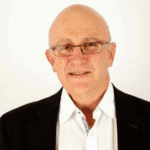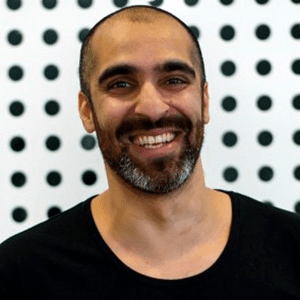

#3: The process of innovation is all about risk reduction and risk mitigation – applying a scientific methodology
John Beech talks about applying a scientific methodology to innovation. Taking the mystery away from entrepreneurship and innovation, ‘something most people learn at school – how to have an idea and test it.’
John assists companies with strategy development and execution with a focus on commercialising innovations developed into global markets.
With over 30 years’ experience in the development, commercialisation and financing of new technologies, John is a Speaker on Business Model Innovation and until recently was a Chair for an international CEO leadership group for over 15 years….Love the problem not your solution!
Stephanie: Today my guest is John Beach. John has been a member of our TEC community now for nearly fifteen years as a Chair, and more recently as a speaker which is wonderful so more and more of our community are hearing from John about innovation and really the scientific method that goes with it. So John does have a career that has really been focused on working with businesses on commercializing an idea, and that’s what I’m really keen to talk to John about today. So John, how come an accountant is the expert on innovation?
John: Well the standard joke in our family is I’m not that kind of accountant but, I had the good privilege to work for Ralph Sarich at Orbital Engine Company, I joined them in ’87 effectively as Chief Financial Officer. And so I had the privilege of seeing technology go from an idea to full industrialisation, to the stage where the joint venture we set up is producing three hundred million dollars’ worth of revenue and profit of about ten or fifteen percent so, yeah, it was great to see the whole journey and you realized actually there was a real process here that you should be able to replicate, so that’s been an interest of mine and there’s so much that’s gone on in that space in the last twenty years.
Stephanie: So we were talking earlier today about the fact that Orbital wasn’t following a textbook. The Lean Start-up hadn’t been written then or Zero to One. They were yet to be written. So what was it that you think Ralph got right?
John: It’s a number of things. They had a joint venture with BHP from the early days and they had a guy called Dr.Dom Swinkles come on board and right from day one they applied the scientific method and captured their IP and were very diligent in learning from every experiment, and that really underpinned so much of what was done at Orbital. And then Ralph was just a natural businessman and he applied a whole lot of things which now people are writing about.
Stephanie: What kind of things?
John: Well there’s a book called Crossing the Chasm which was one of the things that we used a lot in the ’90s and they talked about having a market development plan so, and to be very focused and have a minimum viable product so Ralph’s first engine that he developed was a one cylinder engine which he then took to GM and they financed the project to do a three cylinder engine. But even that was a minimum viable product because they just took a three cylinder engine off the shelf and put the fuel and combustion system on so they basically … he just understood where the intellectual property… he knew the intellectual property wasn’t the piece of metal but how to make the piece of metal work.
Stephanie: Isn’t that interesting? So when… tell me more about the scientific method when you’re saying that’s what you used at Orbital. Tell me what that means to you?
John: Well basically it’s about firstly doing some research, and having a hypothesis and then doing a test to work out that hypothesis; in fact you want to invalidate it, you want to prove it wrong, not prove it right.
And that’s incredibly important and Ralph applied that in a business sense and I will quickly tell the story. He went and spoke to GM and got GM to specify what was the engine they wanted to see and if they saw it in their labs and it met certain specs, that this was a production engine. And so he got their, effectively his opposition to specify what that was. He delivered that and that told him, that was an experiment, but that experiment told him one, they had a problem and he had a potential solution and from that he was then able to get a license which is effectively the product market fit stage. So he did that… he knew that intuitively and when he went back to them and said they wanted to talk about a license he famously put a very large number on the table and they stormed out, weren’t happy with it.
He then went and got a deal with Ford which is effectively the same deal, and 24 hours later… or twelve hours later because I was there when it happened, he received a phone call, GM said ‘we come back cap in hand. We want to exercise our option to a license’. And I think what it shows, he actually ran a commercial experiment; he knew that. He was trying… he didn’t want to go and spend lots of money until he knew that people were going to buy what he had.
Stephanie: So that’s exactly the model now that business start-ups would be following?
John: It should be. It should be. And I think, in fact one of the great strengths of TEC, is the TEC questioning process. The issue processing we do is in fact a variation of their scientific model. And so, what’s the problem that you have got, get all the information on the table, and then once you have got the information, what is the challenge here for you, and what are you looking for? And then ultimately out of those discussions that we have and the clarifying questions and what people put on the table, there comes the germ of an insight; there’s that extra piece of information and I use this quote quite a bit, Jeff Bezos says that, ‘perspective is worth eighty IQ points’. And the number of times I’ve sat in a TEC meeting, and the person you least expect makes a comment which is that aha moment. And essentially what you’re seeing play out is they’re using the scientific method and they’re using the fact that there’s high diversity, and that high diversity, it’s a winner every time. It provides that missing piece.
Stephanie: What I love about what you’re talking about with the scientific method is it takes some of the mystery away from entrepreneurship and innovation; that this is something that most people actually learned at school. About how to have an idea and test it.
John: Absolutely. If you look at the progress humankind has made, it goes back to the adoption, the Industrial Revolution and the adoption of the scientific method. And so in many ways business is all about creating value for customers or making progress for humanity. They’re inextricably linked; it is the mechanism. And so if you want to be successful, be disciplined in that.
There’s another great quote that I like which I think you might have actually provided to me with. Winston Churchill said ‘sometimes people stumble on the truth. They pick themselves up, dust themselves off and walk on as though nothing had happened’. And you go, if you’re applying the scientific method, you will ask the question why it didn’t work, and it’s often those failed experiments that give the answer.
Stephanie: So somewhere in there then, that idea of being able to fail, capable of failing, that’s the entrepreneur then isn’t it? Someone who’s prepared to take a risk, that ‘I might look stupid. I might spend some money that’s not going to work’, or ‘I might have to walk away from my dream’.
John: Yeah, I think, one of the things I learned from Ralph Sarich, I would say was incredibly risk averse and I think a lot of the very good entrepreneurs are, but Ralph had plan b, a, b, c, d, e, f, g, if it didn’t work out the way he wanted. So, when he was taking the risk, and in fact innovation, the whole process of innovation is about risk reduction and risk mitigation that… I’ve got a beautiful slide that was given to me in 1991 by the R&D Manager for Hewlett Packard and it just describes what you’re doing. It’s all about risk reduction doing… Ralph did an experiment with GM which basically de-risked the highest item would the customer buy what he had. He de-risked it, hugely. And by de-risking that he then the… he then went and de-risked every other technical issue, commercial issue, all of that. That’s what we were doing. Or, and sometimes that meant that you had to breakthrough and invent things. And that’s a different kind of experiment but it was de-risking and reducing the constraint. Those two things were happening.
Stephanie: A really important parts of the whole innovation process. So do you think there’s anything that Ralph did that has been perhaps lost today in the approaches to innovation that are more textbook or becoming more mainstream approaches to innovation?
John: That’s a really fine question, Stephanie, and I don’t have an immediate answer though, the thought that occurs to me in response is, Ralph started running his business when he was doing business when he was fifteen. The game of business and Ralph taught me this, the game of business is a people sport, a team sport, and it’s a brain sport. And he knew, get the best engineers on board. And so he basically would get people relatively fresh out of University. He said ‘John I give them a job. I just fail to tell them it’s never been done before, and they just deliver. They deliver again and again’. They don’t have self limiting beliefs, he gets them before those have been put in. So in answer to your question, I think that that team element is one you don’t hear talked about as much as maybe you should.
I think that if you get A graders and, if I look back and I’m in fact catching up with them for a few beers, you know guys like Kim Schlenke, Ken Johnson, Peter Symonds, you know they’re 22, 23 when he pulled them all together, and he viewed himself as the coach. There’s a great video by a guy called Dave Brailsford who was a coach of the UK Cycling Team, and he says, ‘I don’t believe in the thing that there is no I in team’. Everybody in the team is trying, has got something to do, and he had to work out what was in it for them, and they didn’t have to get along, he just had to align and get them going all in the same direction. And I think that’s what Ralph, probably more so than what most people would understand, that was his true skill. He was a very good coach. Not an easy person and I suspect, I never knew obviously, Steve Jobs, but I suspect there was an element of it.
Stephanie: That’s what is coming to mind for me when you’re talking as well.
John: He set the bar high, he helped people achieve what they wanted to, you know, what they never would have otherwise. He allowed them to achieve their potential. I’m not sure that we’ve quite got that. In many ways it’s about the team, it’s not about the widget. It is about the business model. It is about the team. Those are the elements that he kind of meshed in.
Stephanie: And so many start-ups start with the widget, don’t they?
John: Oh absolutely.
Stephanie: I’ve got this idea, I’m going to build it, I’m going to refine it. It’s going to be great.
John: Yep, love the problem, not the solution. And Ralph understood that, he just, there was a moment he had originally started off with a rotary style engine and he went and spoke to a guy at Ford, a very senior guy, and he said, and put forward the proposition of we will have our fuel system and our combustion system on a two stroke engine or a standard reciprocating two stroke engine. The guy was keen as mustard and on the plane back, after ten years work, Ralph changed, he went to that other. And that idea of doing that came from these 25 or something old engines.
Stephanie: And that’s the big thing also, isn’t it, walking away from your baby. Be prepared to let it go and pivot and shift.
John: Yeah. Well that but, the point that he understood there was a job to be done and he understood that that was the key issue. And he also then understood the intangible nature of IP. The intellectual property they had garnered had been worked up on one engine, but it was more applicable to another, and two or three. And that’s the beautiful thing about intellectual property, is you can sell it multiple times. It can do multiple jobs. And so, you can sell it as an engineering project, you can sell it as an option to a license, you can sell it as a license. You can sell it and get a grant, you can sell it and get people to buy shares. One of the things as Chief Financial Officer of a company like Orbital is you’re always looking for money, seriously –
But, what you’re doing is you’ve got intellectual property and you’ll find looking for jobs to be done where you can use that intellectual property and we’ve got really good at it. Tax losses for example, you know, we sold them to people who could use them. It was just a game of trying to find out how you could use your intellectual property better.
Stephanie: What a wonderful story. John, what I always love about talking to you is the quotes, the books you reference. I feel as if I should be taking notes; the good thing is I can listen back to this. Actually my Churchill quote is, I saw it on a beautiful wine bar in Auckland, on the wall and it was, ‘Gentlemen, remember it is not just France we are fighting for, it is Champagne!’. So I think on that note, what a pleasure to see you today John. Thank you so much for sharing your story with us and, see you next time.



